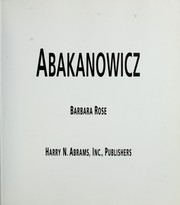Check nearby libraries
Buy this book

Magdalena Abakanowicz's sculpture is known and loved around the world. She is revered by artists and art critics for her uncompromising, individualistic vision, developed in her native Poland under the hostile eyes of the repressive Communist regime that was in power for most of her adult life.
From the horrors of the Warsaw uprising in 1944 to the Soviet invasion of Czechoslovakia in 1968, she has personally witnessed the worst of humanity's instinct for destructive behavior, and has made art that unflinchingly presents the human condition.
Abakanowicz was born to aristocratic parents in 1930 and raised on a country estate east of Warsaw. She came of age against the tumultuous background of World War II and its aftermath. By dint of enormous effort and struggle, she had, by the 1960s, gained the beginning of an international reputation as a sculptor in fibers, a weaver of room-filling environments that were called Abakans.
Always alert to the possibilities of using familiar materials in unforeseen ways, she was soon using burlap and resin to make groups of figures that attracted widespread attention and evoked provocative cultural and political associations wherever they were shown. At the Venice biennial of 1980, her ambitious exhibition in the Polish pavilion caused a sensation among critics and the general public alike.
.
Since then, the level and variety of her work has been nothing short of astonishing. In the 1980s, she began to create powerful and monumental sculptures in bronze, stone, wood, and iron. With works such as Katarsis, Incarnations, and Hand-like Trees, she has transformed bronze casting as she once revolutionized the placid world of weaving.
Abakanowicz has also executed important public commissions for large, outdoor sculptures in Europe, North America, Asia, and the Middle East; envisioned a revolutionary new form of architecture; created a cycle of sculptures called War Games that is at once heroic and tragic; and produced figures of youthful circus acrobats that express life's hopes.
Check nearby libraries
Buy this book

Previews available in: English
People
Magdalena AbakanowiczPlaces
Poland| Edition | Availability |
|---|---|
| 1 |
aaaa
Libraries near you:
WorldCat
|
Book Details
Edition Notes
Includes bibliographical references (p. 208-222)
Classifications
The Physical Object
ID Numbers
Source records
Scriblio MARC recordmarc_cca MARC record
Ithaca College Library MARC record
Internet Archive item record
Better World Books record
Library of Congress MARC record
marc_columbia MARC record
Links outside Open Library
Community Reviews (0)
Feedback?| July 25, 2024 | Edited by MARC Bot | import existing book |
| August 6, 2021 | Edited by New York Times Bestsellers Bot | Add NYT review links |
| February 13, 2020 | Edited by MARC Bot | remove fake subjects |
| July 22, 2017 | Edited by Mek | adding subject: In library |
| December 10, 2009 | Created by WorkBot | add works page |












